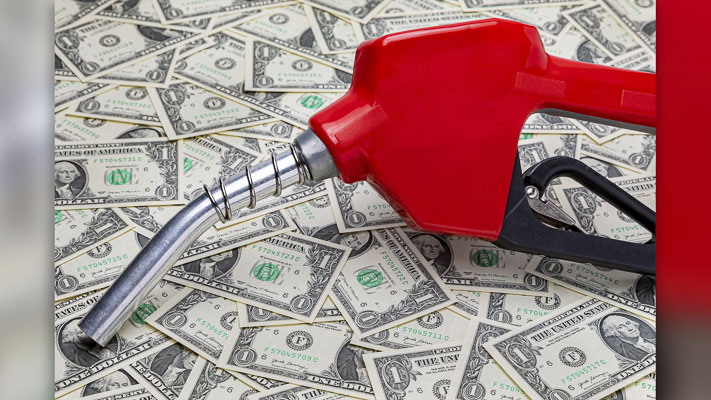
Todd Myers of the Washington Policy Center shares the information that confirms WPC was right that the new law does indeed raise gas prices
Todd Myers
Washington Policy Center
Next year, one of the state’s newly adopted climate policies, the low-carbon fuel standard, will take effect in Washington state. The legislation requires companies to reduce the carbon intensity of gasoline by blending biofuels or funding EV charging stations. Although it has increased gas prices in California and Oregon, the governor and environmental activists claimed it would cost Washington drivers nothing, while the prime sponsor testified that it would cost no more than 2 cents per gallon.

“Don’t let anyone give you that swill that this will increase gas prices,” assured Governor Jay Inslee last year as he signed the bill to impose an LCFS starting next year. Environment activist Leah Missik of Climate Solutions claimed, “Gas prices are not driven” by the LCFS. “Low-carbon fuel supporters say prices won’t increase because there will be more competition in the market,” reported the Northwest News Network.
Rep. Joe Fitzgibbon, the prime sponsor of the LCFS in the legislature, was more circumspect, testifying, “We have to look at the facts. In Oregon, which passed its fuel standard in 2015, six years ago, no credible source suggests it has changed fuel prices there by more than 2 cents.” Were they right? Will it cost little to nothing, as the governor and other advocates claimed, or will it increase the price of energy and gasoline, as Washington Policy Center warned?
The Department of Ecology provided the answer.
The department released its estimate of the projected costs for the first three years the LCFS is phased in, enabling us to compare the projections we made last year with those of Governor Inslee, the prime sponsor Rep. Joe Fitzgibbon, and environmental activists.
The results? We were right, and the LCFS supporters were wrong. Contrary to the predictions, it does raise gas prices.
This is not surprising. Indeed, at the very time Rep. Fitzgibbon claimed that Oregon’s LCFS didn’t increase prices by more than two cents, the state of Oregon was saying that it did. When he made the claim, we already had the 2019 data showing it increased costs by 2.57 cents per gallon. Soon after his statement, Oregon released the 2020 data showing the LCFS increased costs by 3.71 cents per gallon. They recently updated the estimate, showing that for 2021, it increased the cost of a gallon of gas by over 5 cents.
The Department of Ecology is now finding that same thing is likely to happen in Washington state.
Citing an independent report commissioned by the department, Ecology staff wrote, “Washington’s new Clean Fuel Standard will mean less than a 1-cent per gallon difference in the price consumers pay at the gas pump in 2023, according to estimates in a third-party economic analysis. Prices could rise up to 2-cents in 2024, and 4-cents in 2025, the report shows.” The study found that the LCFS would increase “the costs paid by consumers for gasoline, diesel, and electricity.”
It also projected that by 2031, the LCFS would add 19.3 cents per gallon.
The Department of Ecology’s estimate is either “swill,” in the governor’s words, or it shows that Washington will experience exactly what others have seen after the LCFS took effect.
By way of contrast, those projections are almost exactly what we predicted. We predicted that in the first year of the LCFS, it would add about one cent to the price of gasoline, exactly as Ecology’s report indicates. We predicted that it would add about 20 cents per gallon by 2030. Ecology’s report estimates 19.3 cents by 2031. So, we were off by one year.
The truth is, these calculations aren’t difficult. We simply looked at the experience of California and Oregon. We assumed the price impact here would be similar. That is what the Department of Ecology found as well.
It could be argued that an increase of a few cents in the next few years isn’t that much. But the reason the cost is relatively low (when compared to the CO2 tax that will be implemented next year, for example), is that it does nothing. As Ecology staff have admitted, the LCFS does not reduce CO2 emissions more than the new CO2 cap would already. If the LCFS went away, Washington’s CO2 emissions would be exactly the same.
We pay little but get nothing.
For those keeping track, the 19.3 cent increase from the LCFS in 2031 would be on top of a projected 80 cent increase per gallon from the state’s new emissions tax. So drivers in Washington will pay an extra 99.3 cents per gallon in hidden taxes on gasoline in addition to the actual state gas tax of 49.4 cents per gallon and federal gas tax of 18.4 cents per gallon, for a grand total of just over $1.67 per gallon.
It is unclear to me whether the politicians and advocates who said the LCFS wouldn’t increase gas prices were being intentionally misleading or actually believed what they are saying. Either way, they were wrong, and the costs will be paid by Washington residents without any benefit to the environment.
Todd Myers is the director of the Center for the Environment at the Washington Policy Center.
Also read:
- Letter: ‘Here’s why taxpayers should be concerned’Camas resident Gary Perman urges voters to reject RFA Proposition 1, warning of higher taxes, no added services, and misleading campaign claims.
- Letter: ‘The IBR needs a more cost-effective design’Bob Ortblad argues the I-5 Bridge replacement project is overbudget and inefficient, urging a more cost-effective tunnel alternative to avoid excessive tolls and taxpayer burden.
- Opinion: Employers shouldn’t pay workers not to work: Paying people to strike should be a union’s jobElizabeth New of the Washington Policy Center argues that Senate Bill 5041 would burden employers and taxpayers by using unemployment funds to pay striking workers instead of requiring unions to support their members.
- POLL: Should Washington Raise the 1% Cap on Property Tax Increases?Clark County Today’s weekly poll asks whether Washington lawmakers should raise the current 1% cap on annual property tax increases.
- Letter: The more you knowCamas resident Anna Miller criticizes a recent remark by Rep. Jasmine Crockett as racist and demeaning, and outlines Republican contributions to civil rights history in her letter to the editor.











In other words- According to the WPC, drivers could see a hike of $0.46 a gallon and $0.56 a gallon for diesel next year.
Starting Jan.1, many companies that emit carbon dioxide gas will be charged a carbon offset fee based on the amount of CO2 emissions they create. The more emissions, the higher the fee.